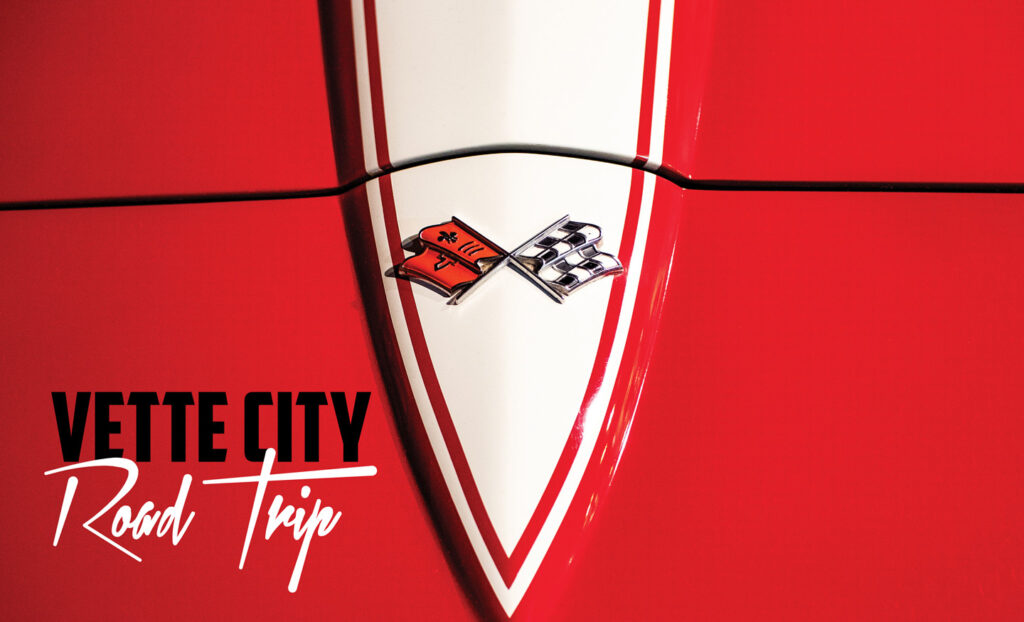To the uninitiated, they may look the same, this fleet of seven Chevrolet Corvettes cruising at 70 mph in a line, staying to the right except when snaking around traffic on this southbound stretch of Interstate Highway 165 toward their destination, Bowling Green, Kentucky.
But each of the Sportster is distinct, made so by differences in color, interior, model year, tailpipes, and vents. The classic, fish-inspired Corvette body today has a European look with scoops and vents that carry fresh air to the engine where it’s mixed with gasoline, sprayed into cylinders, and sparked to create more horsepower than any driver will ever need. This gathering of machines is aimed for Bowling Green like salmon heading upriver, back to their birthplace, the 1.7 million square foot General Motors Assembly Plant, where 1.1 million Corvettes have been built since 1981. This year marks the 70th anniversary of the first Corvette, and Vettes across the country are coming home to Kentucky.
Across the highway from the plant sits the National Corvette Museum, which houses Corvettes from every model year since the model’s debut in 1953.
Across the street from the museum is the 419-acre NCM Motorsports Park, a track where Corvette enthusiasts can bring their car to put it through the paces, or owners can get some driving tips from resident pros.
Corvette drivers are what you’d expect from motorists driving a class of car famous for coolness and pride of ownership. With an average age of 61, the drivers are a decade older than the average Porsche 911 owner. The Vette’s interior, including the width of the bucket seats and the leg room between the pedals and the seat back, dictates the driver should be a person of average height or shorter, and somewhat fit. Corvette drivers share the ability to afford a car that adroitly blends style and speed, with a healthy dash of luxury. Base models of the Stingray start in the mid-$60,000 range, and the 2023 Z06 Corvette is born north of $100,000.
In the summer months, devoted Corvette owners gather in Bowling Green to visit the factory and museum and meet their fellow brand acolytes. They spread throughout the town, standing around Vettes with their hoods up and doors open, sitting in a hotel parking deck, on the lot outside the museum, or in one of the many parking spots around the museum designated “Corvettes Only.”
Although some call it Vette City, Bowling Green, and its 75,000 residents are more than a sports car. Kentucky’s third-largest city, after Louisville and Lexington, is home to Western Kentucky University, with 16,500 students attending the wooded hillside campus each year. The student population is big enough to make Bowling Green a typical, if sleepy mid-south college town.
The GM plant has for decades been an anchor for the town, with 1,400 employees and providing the name for the local minor league baseball team, the Bowling Green Hot Rods.
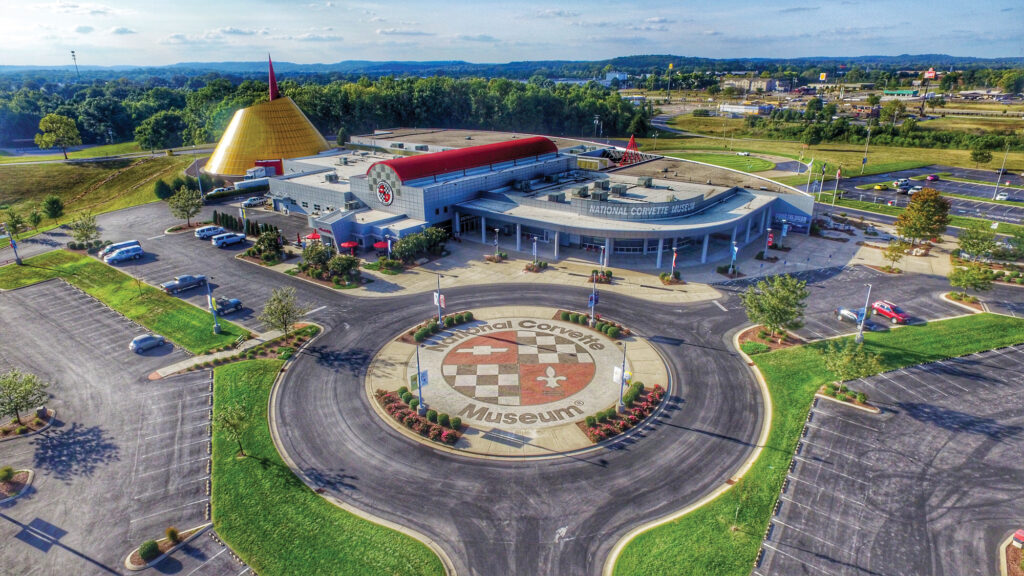
The town is also basking in the glow of the future, as the Envision AESC electric battery plant broke ground last year and is expected to bring in 2,000 jobs. That an EV battery plant will be bigger than the factory where Corvettes are assembled is an ironic sign of the times. GM President Mark Reuss announced last year that an electric Corvette is in the works.
Bowling Green is set among rolling hills of dark green grass in rich soil lying above limestone. The grass nourishes the horses that graze inside pastures edged by wooden fences and race at fabled Kentucky tracks like Churchill Downs and Keeneland. The limestone filters the water pumped into distilleries to make America’s most famous bourbons. And Kentucky tobacco, until recently the state’s largest agricultural product, is fire-cured and dry-cured and used to make cigars for Avanti and Drew Estate.
Driving to Bowling Green in a German luxury SUV made for a nice ride but may not have been the best way to visit Vette City, or so said the security guard at the GM Assembly Plant.
He shook his head and muttered something about “a foreign job” before assigning me to a parking lot farthest from the massive plant’s entrance for the mile-long tour. He said I would surely be ticketed if I dared park within view of tourists leaving the plant.
The plant runs two shifts five days a week, with 94 cars coming off the line each shift, an average of 11 an hour and 188 a day. Bowling Green is an assembly plant, so the parts are made elsewhere and brought to the facility two or three days before they’re needed on the line.
The cars crawl through the plant on a slow-moving conveyor, as the basic parts of the chassis and the body are filled with other parts that form a car. Paint is applied via robotic arms while seat belts, windshields, and wheels are attached by the line workers. In the engine shop, a single worker builds a single engine over a 3.5-hour period, ending the job by stamping his signature on the block.
The final inspection of each car coming off the line is performed by auto workers, who jump into cars moving on the assembly line, try switches for all the lights, start the engine, then drive the car slowly for 20 or so feet over some large speed bumps to check the shocks and steering.
The cars each have 800 gallons of water dumped on them to check for leaks and are driven around a quarter-mile test track with every switch flipped and knob turned. A few cars are randomly taken every day and driven around Bowling Green by drivers trained in how Corvettes are supposed to handle and sound. Any car that doesn’t meet all standards is sent back to the factory for repairs or replacement.
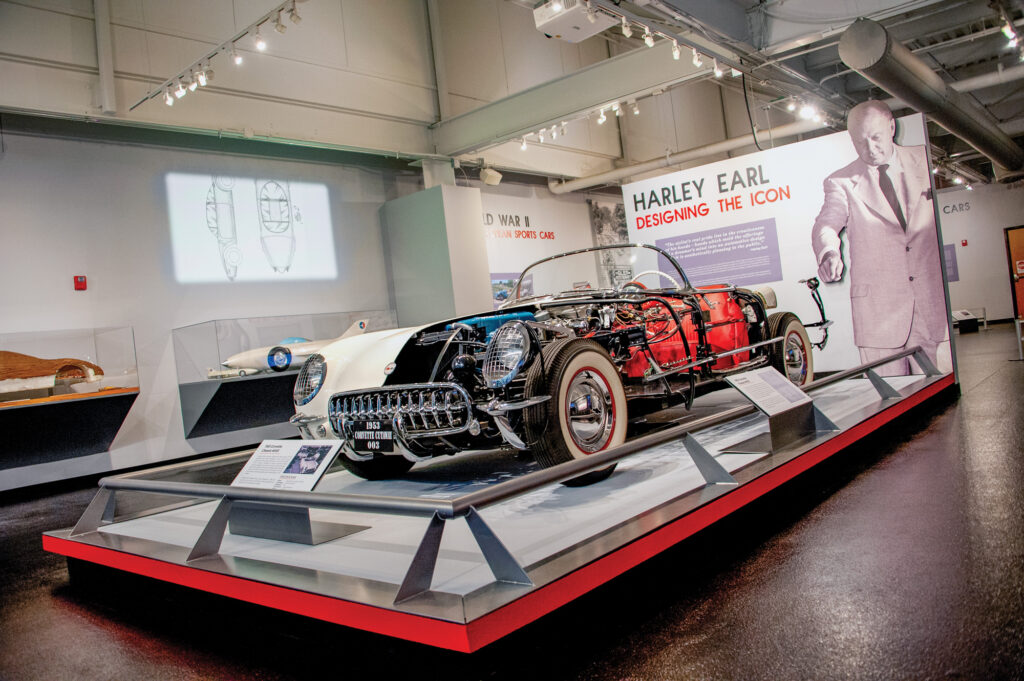
Corvette buyers wait for up to 18 months to take delivery of a new car. They are offered the option of paying a little extra to travel to Bowling Green and take delivery on “The Boulevard” inside the National Corvette Museum. On appointment, their Vette is parked in a spot alongside a plaque congratulating the owner. Corvette technicians spend time with the new owner going over the features of the car. Ten new Corvette owners each day are introduced to their cars this way.
In mid-August, Regine Korn of Naples, Florida, sat inside her new 2023 ceramic matrix gray convertible as friends and relatives stood nearby. Her son-in-law, Peter Rose, said he had ordered the car for himself through a Naples dealership in September of 2021. When the car was ready, he said, his needs had changed. Korn stepped up to say she wanted it.
“She’s so excited,” Rose said. “She hasn’t slept in four days.”
“You know it’s my first Corvette,” said Korn, whose previous cars were an Audi 5 convertible and a Mercedes S500 convertible.“It makes a genuine impression. It’s perfection, that’s what I would say.”
Korn was advised not to test the top end of the car during the first 500 miles, but said she likes how it handles in the heavy rains of southwest Florida and features that allow her to hear the car’s sound system and keep her hair from being blown around when the top’s down.
Roger Holt has worked as a docent at the Corvette museum for less than a year but has been around Corvettes since his older brother bought one in 1968. Five years later, Holt bought his first, a 1965 coup with the famed 327 engine. He’s still got it, although on the day of our meeting, it was in the garage in need of brakes. In its place, he drives a black 2000 LS1 coupe.
“There’s a status to them,” he said. “There’s a cool factor…”
The museum is a non-profit organization opened in 1994. Vette fans can check out the first Vette, one of 300 built-in 1953, all of them white with red interior and a black top. Only two options were available in the first year: you could decide if you wanted to add a heater and a radio. The doors didn’t lock or even have windows.
While Chevrolet designers and engineers were excited by the car, sales were disappointing. General Motors considered shelving the Corvette until in 1955 engineers gave it more power by installing a small-block V8. The larger, faster engine forever united the ideas that Corvettes should be sleek, fun, and powerful.
That’s about the same time that engineer Zora Arkus-Duntov started lending his ideas to the car, developing ways to get more horsepower or at least make the car look like it. Through years spent working on the car, he came to be called the “Godfather of the Corvette,” and was so dedicated that an urn carrying his ashes, and another of his wife, Elfi, are on display at the museum.
“He always made everything better and faster,” Holt said.
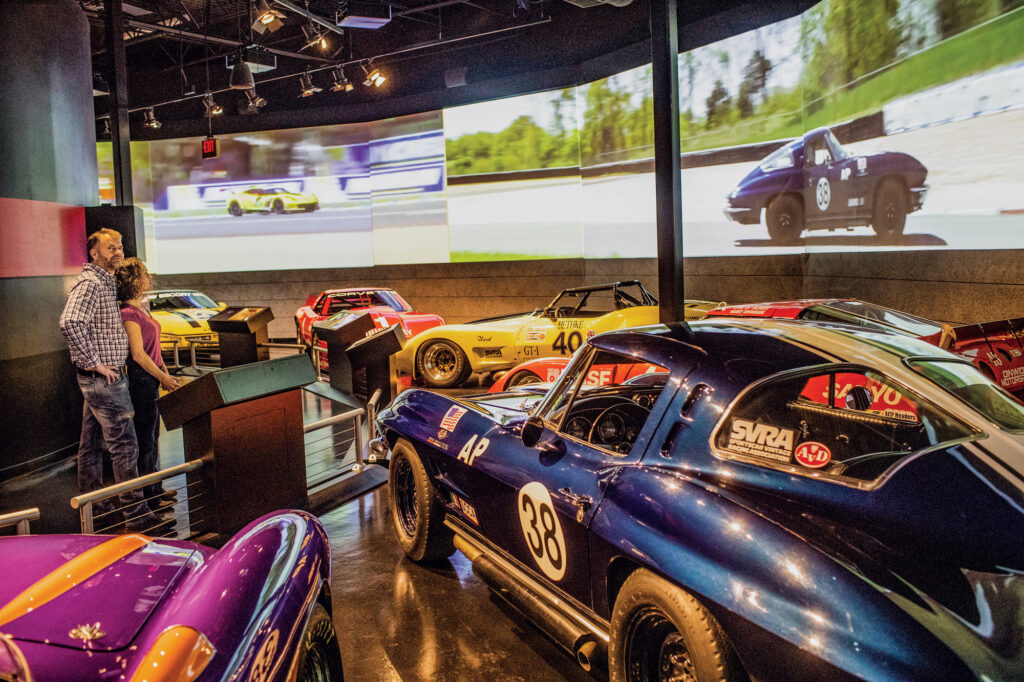
The museum features every Corvette breakthrough since 1953, some of which never made it to market, like the 1965 XP819 with an experimental rear engine. Visitors can check out the 1961 Mako Shark created after designer Bill Mitchell landed one on a fishing trip, and the 2019 C7 2RI that reached 219 mph, faster than NASCAR and about the same speed as open-wheeled race cars at the Indianapolis 500.
The early Corvettes were manual transmission only, with a three-speed introduced in 1956 and a four-speed the following year. That feature is unavailable now, and for good reason, Holt said.
“Sure, there’s something satisfying about putting that stick in gear, but manual transmission would only slow them down,” he said.
The museum may be best known for the sinkhole that formed overnight in the museum’s rotunda in February 2014. The eight Corvettes it swallowed were pulled out and restored and are now part of a display recalling the moment. Windows on two steel panels in the floor allow visitors to look down to the bottom of what was the sinkhole.
The museum includes a 2024 E-Ray, the first hybrid Corvette with electric motors on all four wheels and an LT2 V8 engine. Working together, they produce 655 horsepower and torque that can slam the car from zero to 60 in 2.5 seconds, the quickest Corvette ever. In “stealth mode,” the E-Ray can cruise on its electric motors for short trips.
And while it would be illogical to imagine Corvette designers and engineers not wanting to equip an experimental model with four electric motors and a floor full of batteries, Holt shook his head at the idea of a fully electric Corvette.
“They spent so much money and time perfecting that sound,” he said of the Vette engine’s rumble.

Visitors to Bowling Green will find Corvettes sprinkled everywhere around town, some parked in spots around ornate Fountain Square Park, among the shops, bars, and restaurants. Spenser’s is a mainstay for coffee and baked goods, attracting students and townies to its renovated building of wooden floors and brick walls.
There are plenty of opportunities to treat yourself at the Meltdown Ice Cream and Soda Fountain and Insomnia Cookies. For something more serious, the square offers Cliffs of Moher Irish Pub for beer, cocktails, and live music some evenings, or The Dusty Boot, Gerard’s 1907 Tavern, Dublin’s Irish Pub, and The Copper Bar. Toward the college, you can hit Hilligans Sports Bar & Grill for beer, wings, and pizza.
Cocktails and dinner can be found on the square at 440 Main, for seafood, steaks, and Cajun cooking, or next door at Micki’s on Main for the same fare in a more casual environment. A few blocks away, Hickory & Oak offers a solid selection of bourbons, great steaks, seafood, and pork tenderloin, along with some oddities like Nordic elk. Or you can dine in a restored 1893 house at The Bistro, offering Italian American fare and martinis.
Anna’s, a Greek restaurant, is inside what was the Victory Baptist Church. The 115-year-old building had been vacant for 10 years before Anna and Vilson Qejaha purchased it and spent the next five years restoring it and converting it into a restaurant. It offers Mediterranean food created by Anna, a chef who owned a restaurant in Kamari, Greece, before coming to the U.S. The huge stained glass windows behind the bar and the chandelier hanging from the dome over the main room create a unique dining environment.
A number of hotels can be found along the interstates on all sides of the city, including some motor inns built in the 60’s. The Hyatt Place Bowling Green in the College Hill Historic District is conveniently located, well-equipped, and well-run. The Kentucky Grand Hotel is a recent addition with the restoration of a building close to Fountain Square converted into eight suites.
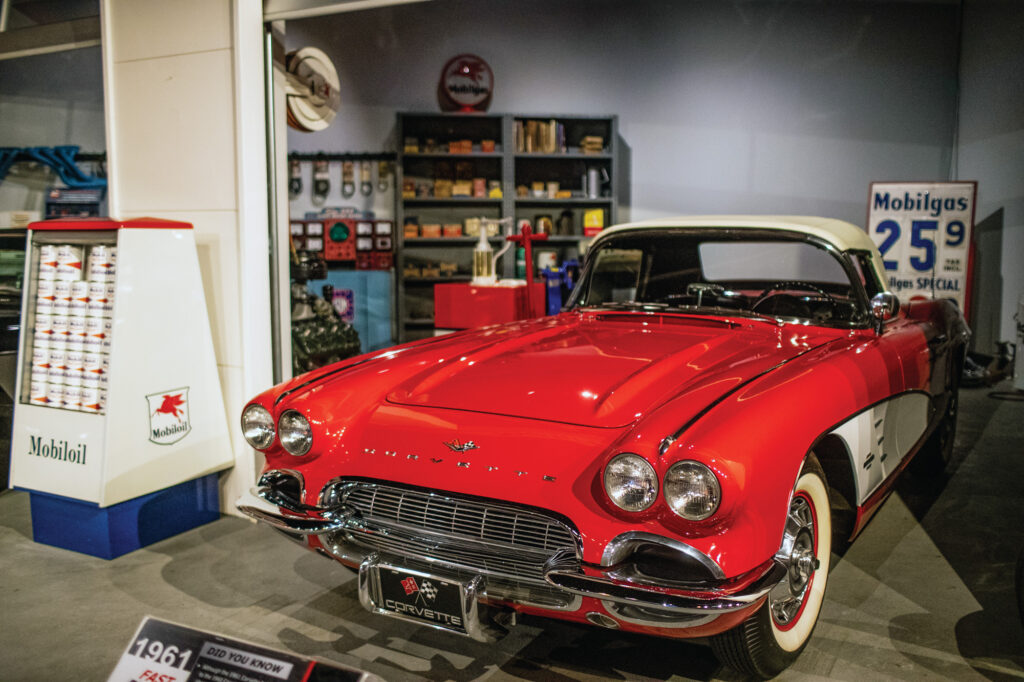
Tobacco has a history in Bowling Green, seen in the faded lettering across a converted warehouse on the edge of town, now a location for weddings and parties, advertising Scott Tobacco Co. and its products, the Mammoth Cave Sweet Twist and Clover Bloom. Thompson advertised on postcards as “A Chew For Every Taste.” It was also smoked in a pipe and advertised for medicinal purposes and sacred blessings.
Smokers who would rather have a premium cigar can head to Bowling Green Pipe & Cigar on Fountain Square, in business for 50 years and purchased 15 years ago by Andrew Cole and Chris Abend. In mid-summer, the shop is cool with dark wood providing a feel of history, a large walk-in humidor built across a wall at the front, and a bar in the back, with stools and an array of Kentucky bourbons.
“We’re the only place in town where you can legally smoke and drink,” Cole said, adding the top sellers in the humidor are Padrón and Arturo Fuente. The constant flow of Corvettes into Bowling Green is good for business. “It brings people to town, and a lot of people who drive Corvettes seem to be cigar smokers,” he said.
Two Bowling Green regulars, Kevin Waldron and Ralph Beck, sat around a table under the awning in front of the cigar shop, exuding an aloof cool and enjoying an afternoon cigar while watching a restaurant down the block being readied for the dinner crowd. Asked if they owned Vettes, Waldron said his daughters told him he wasn’t old enough yet. Beck drew on his Padrón and said he had one on order but wasn’t sure if he’d take delivery.
Mark McGehan retired after a career with General Motors, his last years working as operations manager at the Bowling Green plant. He’s the proud owner of a 2023 2LT Stingray convertible and active member of Corvettes Limited Bowling Green.
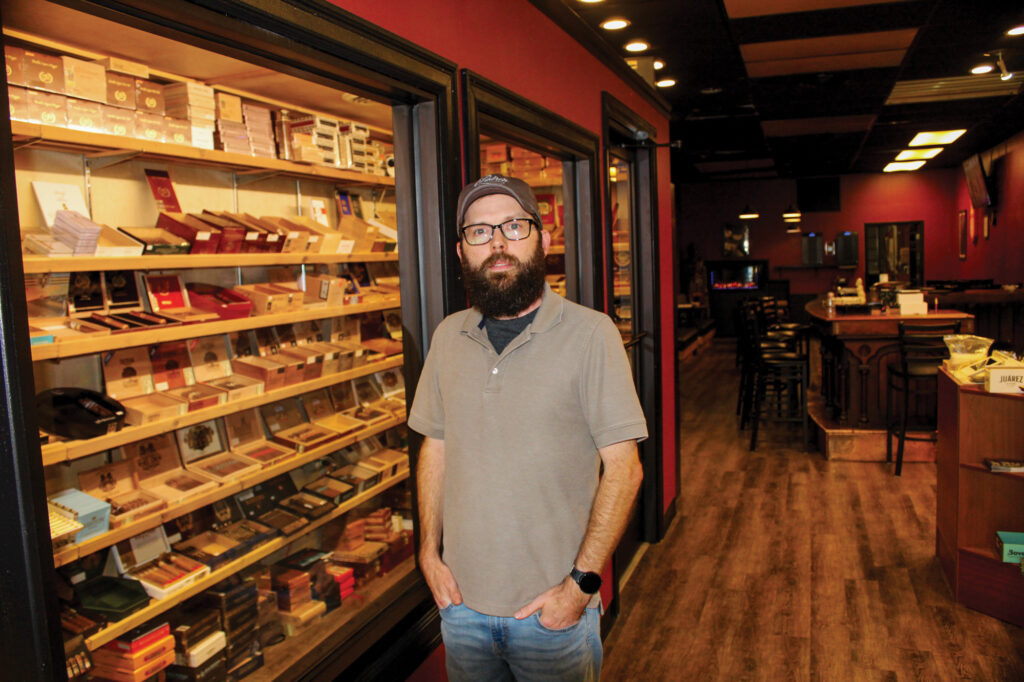
McGehan’s first Corvette was a 1972 model that he bought used, and he’s owned a number of Vettes since then. “Let’s round it off at probably 10,” he said. He had started working in a Corvette racing shop as a go-fer at age 11, and learned auto mechanics throughout his teen years until he joined a racing crew.
The active Bowling Green club can bring out 80 members for drives and events. A cruise on a summer day to a town a distance away may result in a line of 30 to 40 Corvettes running down the road.
“It’s a blast,” McGehan said. “This car is absolutely incredible. The handling, the ride, the performance of the car is amazing.… Corvette’s popularity stems from Americans’ love for the automobile. And the Corvette is the longest-standing American sports car.”

